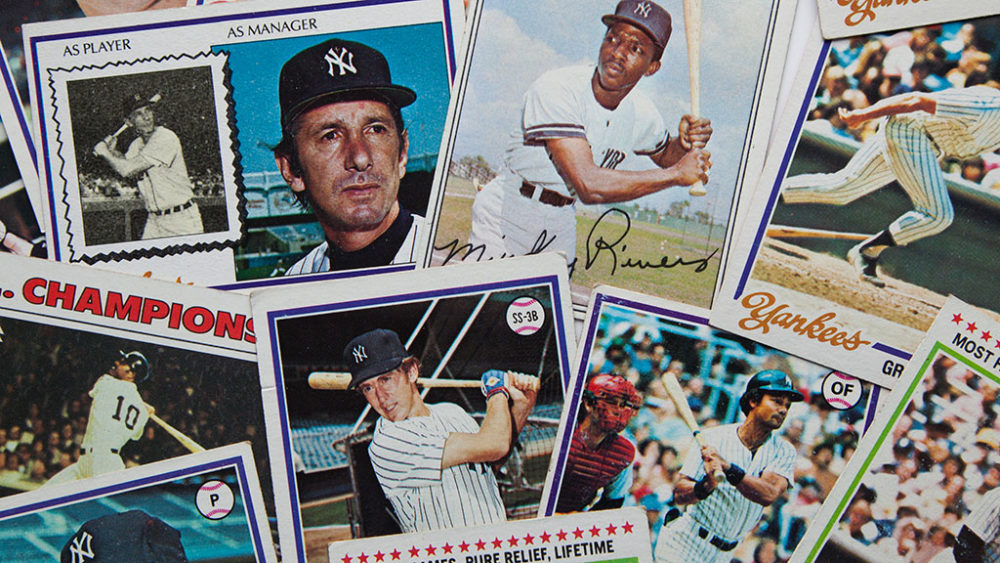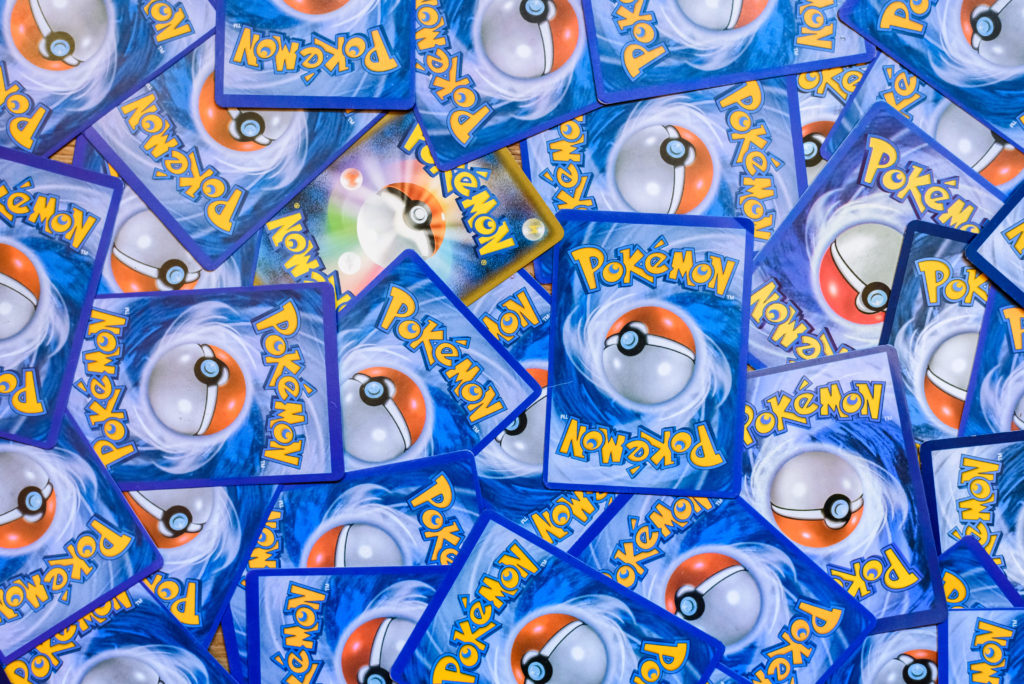
It seems like everything old is new again — the world is rife with high-waisted jeans, reboots of ’90s shows, and the reemergence of popular games from decades ago. Nostalgia is like comfort food for our psyches, drawing us back to sunny afternoons spent haggling and bartering over our most precious possessions, whether those are Polly Pockets, Tamagotchis, or trading cards. More than a century after their introduction in the late 1800s, trading cards are still one of the most profitable and most popular items to buy, sell, and trade.
WHERE DID WE COME FROM AND WHERE DO WE GO?
Trading cards have been around since the late 1860s. According to the Cornell University Library, trading cards originated as trade cards, which were tiny pieces of paper that advertised sellable goods like oyster crackers or cigarettes. As new developments in technology allowed for more businesses to invest in color printing, the hype around trade cards petered out, only to reemerge at the beginning of the 20th century.
Around the same time that baseball became a professional sport, sporting goods company Bowman Corp. began printing cards featuring famous baseball players. In an attempt to appeal to a younger audience, most baseball trading cards came tucked into candy and tobacco products — an extra treat for die-hard fans — and the industry boomed.
Although trading cards remained in vogue from the early 20th century to the ’80s, the product really took off in the ’90s. “The hobby of collecting cards was rooted in a community back in the ’70s and ’80s, going to card shows at malls and local shops. [But] the ’90s collecting boom kicked all of that into high gear,” explains Adam Gellman, founder of the online blog Sports Cards Uncensored. “Card companies were putting out millions of copies of each card.”

REACHING NEW HORIZONS
However, sports cards weren’t the only trading cards making a mark. Some of the most iconic pop culture brands started off with collectible cards in the ‘90s: Sailor Moon, Yu-Gi-Oh, and Pokémon. On Feb. 27, 1996, Pokémon launched its first two video games, followed closely by the Pokémon Trading Card Game (TCG). Pokémon found commercial success because of its multigenerational products. As Courtney Kim, product marketing manager for the Pokémon TCG puts it, “Fans who grew up with the brand are now parents themselves and want to share their love of Pokémon with their children.” Not only does the brand lean into nostalgia, but it also opens the door for younger generations to find and fall in love with the thrill of collecting. Scott Pratte, one of eBay’s most profitable collectors and sellers of Pokémon trading cards, agrees. “The ’90s Pokémon mania was like nothing else. The cards were a fun way to interact during the ’90s craze: Seeing what each Pokémon would look like in a set, how strong it was … enhanced the Pokémon and ‘90s experience.”
The hype over Pokémon cards has sustained itself throughout the brand’s 25 years, finding its niche in the online collecting community. Many collectors, including Pratte, have made a business out of buying and selling Pokémon cards. Unlike sports cards, Pokémon cards have an added appeal of special- or limited-edition cards with limited runs. Players can receive these cards at tournaments, such as the Word Championships that took place annually before the pandemic.
“The trophy cards in Pokémon (the rarest and most valuable) are the best,” explains Pratte. “Not only are they rare, but they are also typically only awarded at a tournament to the winners, and the art tends to capture the event.” To Pratte, and perhaps other collectors, Pokémon cards are valuable because their rarity has a purpose. When players win a Pokémon TCG tournament, the cards they win represent their victory.
Of course, each card has monetary value. In fact, the trading cards category on eBay has had an upward sales increase for the last seven years. According to Bob Means, director of trading cards at eBay, “2020 was a breakout year that saw an industry-wide surge in collecting and flipping trading cards. eBay’s trading cards category grew 142% that year.” Last year, an average of two trading cards were sold every second on eBay.
More collectors are flocking to eBay to sell their stashes, enticed by the website’s auction-based platform, which has become such a popular hub for selling cards that eBay recently implemented — and then expanded — its authenticity guarantee to combat fraudulent products. For cards valued at more than $250, sellers now must ship the product directly to third party authenticators before it gets sent to its new home. It comes in handy when these Pokémon cards can go for upwards of $20,000.

TRADING CARDS IN THE DIGITAL AGE
Some of the trading card hype from the past few years can be attributed to the COVID-19 pandemic. With more time to invest in hobbies like trading cards, the industry surged, filled with people rediscovering their passion for their collections of yesteryear. And although the world returned to semi-normalcy this year, the industry has not waned. eBay is still reporting record sales numbers, including triple-digit growth in the overall trading cards category.
As more collectors begin selling on eBay, the website is seeing an increased interest in digital cards in the form of non-fungible tokens (NFTs). This year, eBay “will add new capabilities that bring blockchain-driven, digital collectibles to eBay, including the sale of NFTs,” Means says. The website currently boasts a wide variety of NFTs, from a Tom Brady rookie card to an NFT of Kurt Cobain’s last photoshoot, and is looking to add trading cards to its résumé. eBay is poised to become a major player in the buying and selling of NFTs.
Trading cards are also beginning to enter the larger digital space. Fanatics, a global digital sports platform, acquired Topps Trading Cards earlier this year with the intention of launching a new, digital trading card market. Shortly after the two brands merged, Fanatics released zerocool, which offers products direct-to-consumer using a blind auction. Since its initial launch, zerocool has collaborated with NFT brand VeeFriends and, most recently, the Jackass film franchise. Both collections featured original, digital trading cards that fans could bid on on zerocool’s website, paving the way for a completely new and untouched market for trading cards.
Similar to how trading cards initially were targeted at kids, this pivot to the digital realm promises to entice younger generations. “With Fanatics taking over the production of cards … we’ll see a really strong effort to widen the base of collectors,” agrees Rich Mueller, editor at Sports Collectors Daily. “Collectibles are a big deal to the younger adult demographic right now, to the point where they see the best cards and memorabilia as valuable investments.”
Despite not living through the ’80s and most of the ’90s, these younger generations are drawn to this sense of nostalgia. It’s become cool to collect items like records, vintage clothing, and trading cards. By shifting the industry to a digital space, Fanatics is opening the door for young adults to discover the joys of collecting trading cards by catering to their generation’s zeitgeist.
Fads have come and gone, but trading cards seem here to stay, whether in physical or digital form. As card companies expand into new markets with broader offerings, the growth in the trading card industry shows no signs of slowing down. Gellman agrees: “I think there will always be a market for cards. Always.”
This article was originally published in Issue No. 13 of the Pop Insider. Click here to read the full issue!
